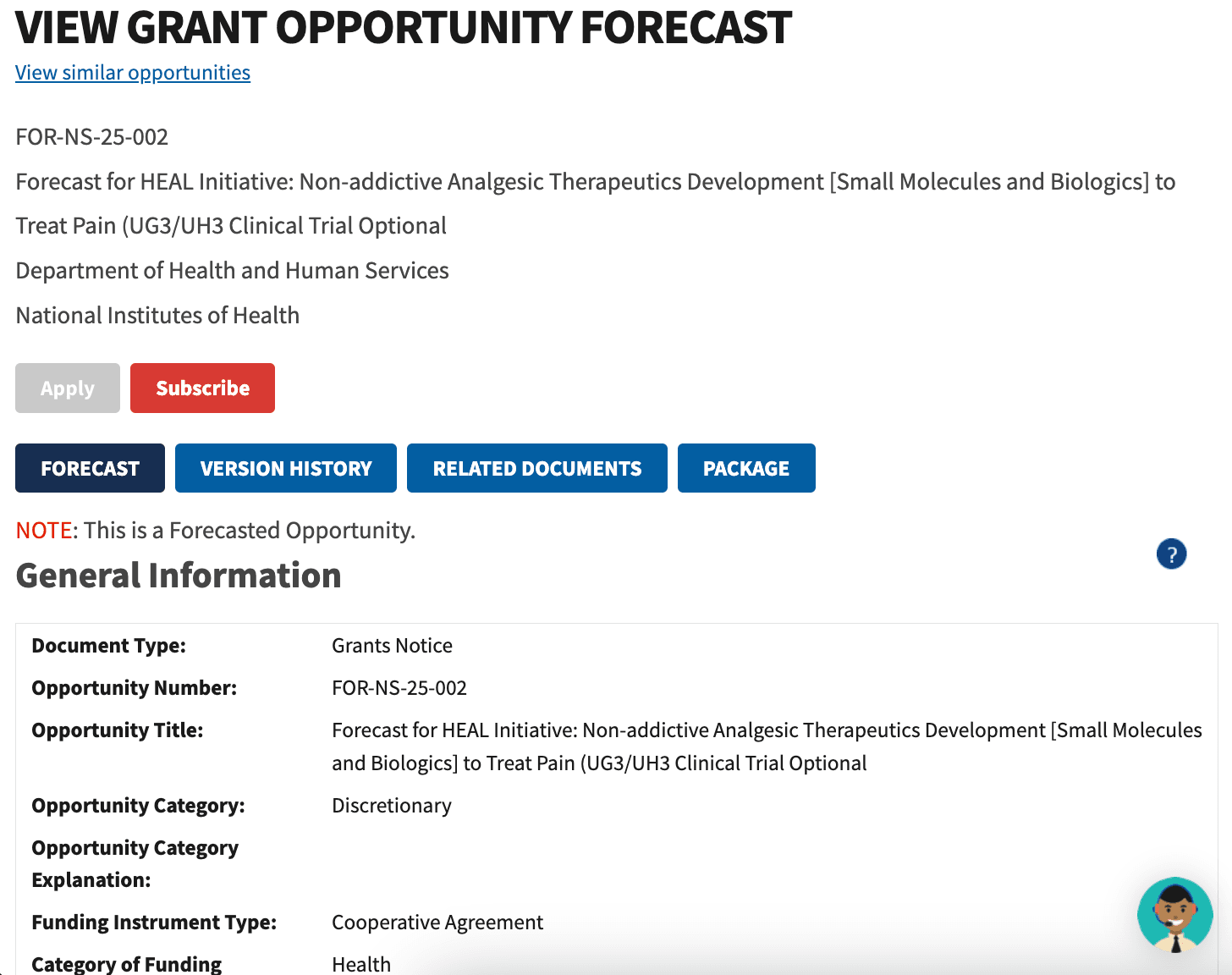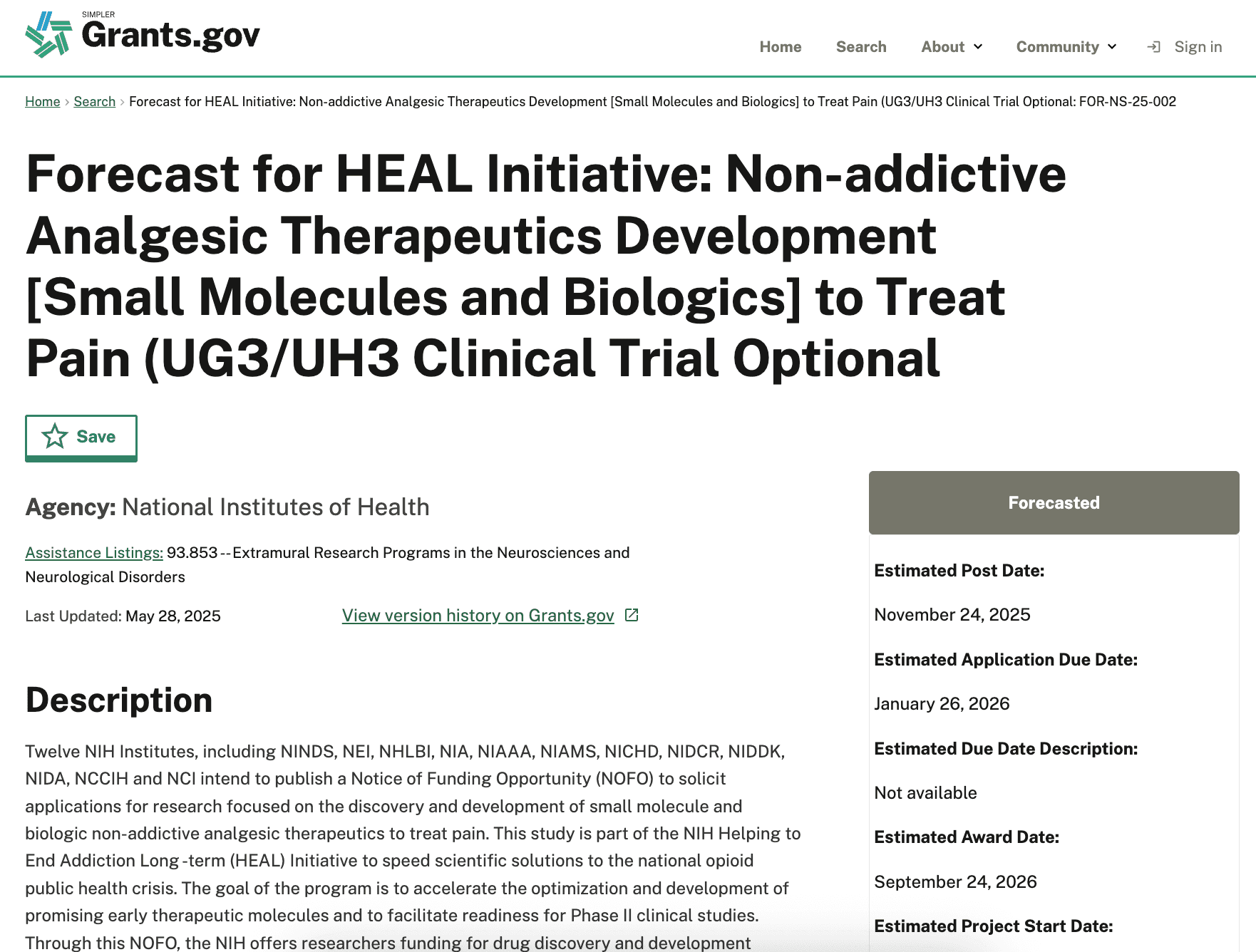Impact stats
As of August 2025, over 100,000 people are using Simpler.Grants.gov each month
25% of search traffic from the legacy Grants.gov are using Simpler Search
6 steps required to create an account on Grants.gov, down from 82 steps.
Summary
The U.S. Department of Health and Human Services (HHS) oversees Grants.gov, a federal service that connects grant seekers with more than $300 billion in public funding each year. With the goal of making Grants.gov the simplest, most effective, and easiest way to find and apply for financial assistance, HHS tapped Nava to help scale modernization efforts of Grants.gov. We’re helping HHS build Simpler.Grants.gov — an open-source, modernized digital service that will replace Grants.gov in a phased, user-tested transition.
Approach
The current Grants.gov is built on a legacy code base and architecture from 2002. We’re helping HHS build a new code base and architecture, which will modernize and optimize all of the functionalities that grant seekers use on Grants.gov. This modernized experience lives on Simpler.Grants.gov, which will eventually replace Grants.gov and become the default service.
One of the efforts HHS decided to modernize first was Grants.gov’s search feature. We’re helping HHS build Simpler Search, a new search experience that’s human-centered and mobile-friendly. To build Simpler Search, we helped HHS build a back-end process that pulls grant opportunity data from the same sources as Grants.gov and surfaces it on Simpler.Grants.gov. We also leveraged plain language best practices for more effective communication and user research to help HHS improve grant opportunity listings on Simpler.Grants.gov.
Outcomes
We helped HHS launch Simpler Search alongside the legacy search experience on Grants.gov, giving grant seekers a choice between the two. This promotes a gradual shift to the new search experience, rather than abruptly forcing grant seekers into something unfamiliar.
Simpler Search is an efficient and effective feature that enables grant seekers to search for and save grant opportunity listings. Grant seekers can also save searches, create lists of their saved opportunities, and subscribe to email alerts for saved searches. As of August 2025, Simpler.grants.gov is serving more than 100,000 active users each month. As of publication, grant seekers have saved 7,460 opportunities and 374 searches since launching the service.
In addition to helping HHS build Simper Search, we’re working with the agency to pilot an end-to-end grant application journey. Eventually, grant seekers will be able to use the new application to search for, find, and apply for grants. So far, we’ve focused our efforts on understanding how Grants.gov gathers data from grant seekers through web forms and identifying ways to improve the process. We also helped HHS reduce the number of steps required to create an account on Grants.gov from 82 to six.
All of the software we’re helping HHS build is open source, meaning anyone can access the code or leave suggestions on how to improve the site. Building open source software makes the Grants.gov modernization process highly transparent, it promotes easy collaboration between government agencies and vendors, and it helps avoid vendor lock-in.
By sharing their work publicly and inviting feedback, the Simpler.Grants.gov team has issued more than 40 API keys, meaning we’ve given API access to more than 40 developers who can use grants data to integrate with existing systems or build new databases. The 40+ API keys have supported over 100,000 external API calls, which means external systems have accessed grants data more than 100,000 times. Finally, we helped HHS gather input from 32 research participants and conduct 35 one-on-one interviews to shape key features.
Process
Creating a simpler search experience
HHS wanted to build a search experience that works for everyone who uses Grants.gov. To achieve this, we began by building a minimum viable product (MVP) of Simpler Search and tested it with grant seekers, grantors, and HHS staff. Each test participant conducted searches in Grants.gov and Simpler.Grants.gov, and compared their experiences. From these tests, we identified several areas for improvement, such as adding the ability to use advanced filters (e.g. geolocation, date ranges), simplifying jargon, and building tools like shareable links that enable collaboration.
“My organization can't function without this search. Great work on making it. […] You're not getting confused as to what you're looking at. So I think that's really fantastic.” - User research participant
User testing also revealed ways to improve content design on grant opportunity listings. When someone clicks on a grant opportunity listing on Grants.gov, they’re taken to a page that shows important information about the opportunity, such as eligibility guidelines and application due date. HHS wanted to make these opportunity listing pages more user-friendly, so we helped conduct an evaluation of opportunity listing pages on Grants.gov. We assessed the pages’ usability against content and design best practices and conducted a competitive analysis against similar sites. This work enabled us to help HHS create several versions of a new opportunity listing page. After testing the pages with applicants, grantors, and HHS staff, we iterated and came up with a working design. In the new design, HHS moved the most important information to the top of the page and the right side bar.


Top: Grants.gov opportunity listing; bottom: Simpler.Grants.gov opportunity listing
“It's a lot cleaner and nice and tidy. You've got the title real big at the top; that's super.” - User research participant
Importantly, we used open-source components of the United States Web Design System (USWDS) to build the opportunity listing pages. This enables HHS to quickly prototype and build new pages, and because USWDS components are modular, HHS can use components that serve their specific needs.
Building out the backend
To populate Simpler Search, we needed data on grant opportunities. Many government projects build software using production, or mock data in a sandbox environment. However, HHS wanted to build Simpler Search using the same data sources that Grants.gov uses. That’s because production data would enable us to conduct more meaningful usability testing and mitigate the risks associated with moving from a sandbox to production environment.
We helped HHS build a back-end process that copies production data from Grants.gov to Simpler.Grants.gov, enabling us to work with production data without impacting Grants.gov services. We partnered with HHS to build an application programming interface (API) that exposes the copied data on Simpler.Grants.gov via a modern REST interface. This is essential for services like Simpler Search to function, and it allows public access to Simpler.Grants.gov’s data. The latter is important because it enables developers at grant-seeking organizations to quickly access opportunity data, helping organizations efficiently find opportunities.
Optimizing the end-to-end application workflow
We’re helping HHS pilot an end-to-end application workflow for Simpler.Grants.gov. When this work is complete, people will be able to search for, identify, and apply for opportunities using the modernized workflow.
So far, we’ve conducted research and interviews with diverse populations who use Grants.gov. This enabled us to map the end-to-end application workflow and identify areas we can improve on, such as how grant seekers fill out opportunity web forms.
From here, we’ll help HHS build a user-friendly application workflow. First, we're helping HHS pilot an MVP of the application workflow with 10 people. Once we’ve gathered feedback from the pilot, we’ll scale the pilot to more people and we’ll start to add richer features to the workflow.
As HHS begins the pilot, our user research is informing the work we prioritize. For example, we heard from grant seekers that the experience of finding and filling out web forms on Grants.gov can be frustrating due to outdated technology. So, we’re working with HHS to optimize the application page where grant seekers can see all of the forms associated with an application. We’re also helping HHS improve the usability and effectiveness of the forms themselves. On the backend, we helped create functionality that will enable HHS to manage forms as the service scales. This is important, as there are over 130 web forms in the Grants.gov ecosystem.
Agencies that post opportunities on Grants.gov will be able to configure the posting to their unique needs, without needing a software engineer to write custom code. That's because we worked with HHS to create a flexible library of all the forms required across grant applications, enabling configuration over customization. This empowers grantors and reduces burden on HHS staff, who would otherwise need to help grantors set up their opportunity listings.
Conclusion
Grants.gov is a critical public service that connects the organizations people depend on to hundreds of millions of dollars in funding every year. Given Grants.gov’s far-reaching impacts, HHS is prioritizing modernizing the service to make it the simplest, most effective, and easiest way to find and apply for public grants. Nava is helping HHS build Simpler.Grants.gov, a user-friendly, intuitive, and modern replacement for the legacy Grants.gov. Our shared work is improving experiences and outcomes for grant seekers, grantors, and HHS staff.
Written by

Program manager

Senior product manager

Senior Editorial manager
